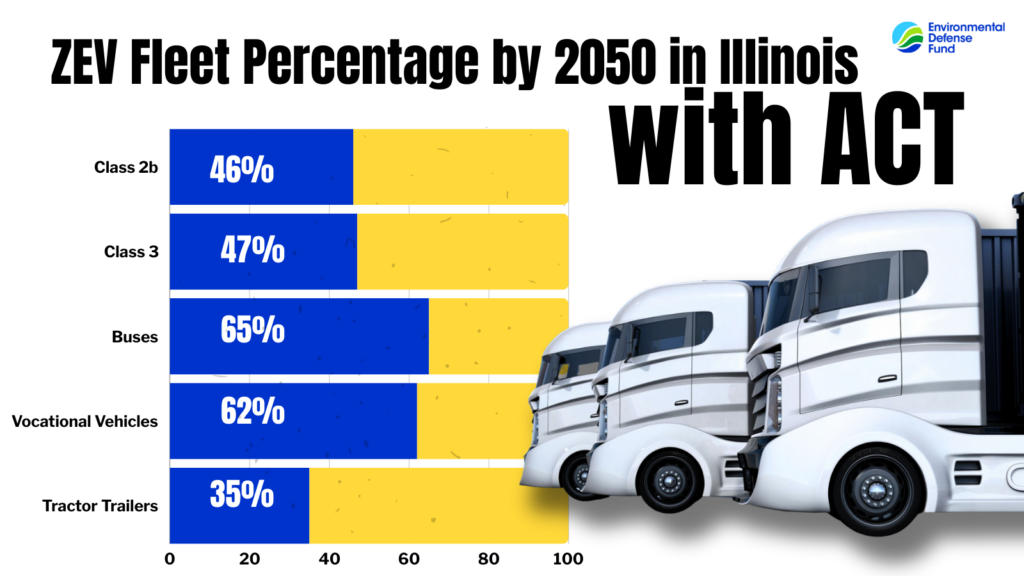Northwestern analysis provides more information on the need for ACT in Illinois
This blog was co-authored by José Acosta-Córdova, Senior Transportation Policy Analyst at LVEJO
Transportation is a big issue in Illinois, accounting for almost one-third of the state’s greenhouse gas emissions — the sector responsible for the most GHG emissions in the state. Medium- and heavy-duty vehicles, such as delivery vans, transit buses and large tractor-trailers are a disproportionate contributor of greenhouse gas emissions, but also other emissions like nitrogen oxide and particulate matter that directly harm the health of Illinoisans. Despite making up less than 10% of on-road vehicles, these trucks and buses are responsible for 67% of NOx and 59% of PM.
Advocates in the state have long been calling for Gov. Pritzker to move forward on key policies to advance zero-emission trucks and buses. Chief among them is the Advanced Clean Trucks regulation, which requires manufacturers to sell an increasing percentage of zero-emission trucks and school buses.
New analysis, the result of a collaboration between EDF and Northwestern, and informed by key input from community partners, demonstrates the significant positive impact that the Advanced Clean Trucks rule can have in the greater Chicagoland area. If implemented starting in 2027, this regulation will result in approximately 50% of medium and heavy-duty vehicles on
Illinois roads would be zero-emission by 2050. Assuming technology and conditions are the same as today, that change could avoid around 500 deaths and about 600 new cases of childhood asthma every year across the seven counties included in the Chicago Metropolitan Area for Planning region.
Northwestern analysis provides more information on the need for ACT in Illinois Share on X
Pollution from medium- and heavy-duty vehicles is more prevalent in communities living near commercial truck-attracting facilities, freight corridors and inland ports. More often than not, the communities living near high volumes of truck traffic and resulting pollution are made up of low-income and people of color. This trend of disproportionate harm has been borne out by multiple analyses — including EDF’s proximity mapping that shows the 2,400 warehouses in the state surround neighborhoods facing heightened pollution risk and truck counts undertaken by groups like Little Village Environmental Justice Organization. Truck counts done by LVEJO show that truck traffic happens disproportionately in communities of color; similarly, EDF’s proximity map data shows that Black and Hispanic/Latino populations live near warehouses at rates more than 37% and 95% higher, respectively, than would be expected based on statewide statistics.
Illinois needs to take decisive action, and do so as soon as possible. The EDF and Northwestern report anticipates the following outcomes of implementing the ACT in 2027:
- A reduction in nitrogen dioxide concentration of up to 18% in the most impacted census tracts, and an average reduction of 8%.
- Health benefits in all census tracts in the Chicagoland region, with the largest benefits in neighborhoods with higher percentages of residents of color. For example, while the region as a whole is 17% Black, 23% Latinx, 7% Asian, and 51% white, the areas with the largest NO2-associated reductions in mortality as a result of the ACT are 48% Black, 12% Latinx, 7% Asian, and 31% white.
It’s important to recognize that, with respect to the Latinx community, health impact analyses like these can reflect a seeming paradox. Despite disproportionate pollution burdens and cumulative impacts from other socioeconomic factors, Latinx Americans on average tend to have lower mortality rates. But respiratory and other pollution-related ailments are often significantly undercounted and modeling approaches do not fully reflect cumulative impacts from pollution and other socioeconomic factors.
The evidence continues to pile up: for the health of Chicago’s most affected residents, the state must adopt the Advanced Clean Trucks rule as part of a suite of strong, stakeholder-led policies. The time to act is now.











